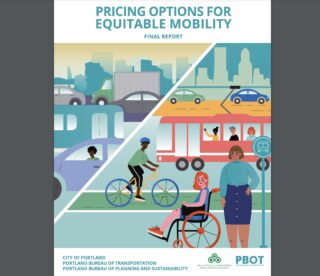
The free ride for car, truck and delivery drivers in Portland isn’t over, but the end has never been easier to see.
At City Council Wednesday, Mayor Ted Wheeler and the four other commissioners voted unanimously to adopt a resolution that will allow the City of Portland to develop a suite of new transportation-related fees. These “pricing strategies” include six near-term recommendations developed by the Pricing Options for Equitable Mobility (POEM) Task Force, an 18-member committee that spent 16 months hashing out the best ideas and putting them into a list of recommendations released back in July.
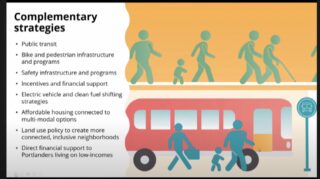
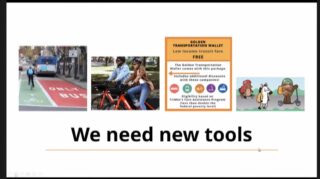
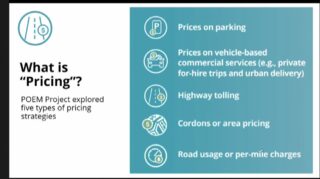
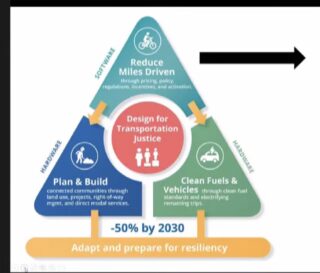
(Above: Slides presented at the council meeting Wednesday.)
Portland transportation planners and policymakers have known for years that putting a higher price on driving motor vehicles is imperative if we want to meet our climate and transportation goals. But charging people more to drive cars — in any shape, way or form — has always been a lightning rod of controversy. In progressive Portland, that controversy has been not only about the sacred American value of keeping driving cheap and easy, but also about equity. If we charge people more to use cars, the thinking has always gone, it would hurt low-income people and communities of color more than others (which isn’t really true, but narratives often trump facts).
So when the City of Portland put together the POEM Task Force in late 2019, they asked its members to, “Inform PBOT (Portland Bureau of Transportation) and BPS (Bureau of Planning and Sustainability)… if and how new pricing strategies could… be used more intentionally to improve mobility, address the climate crisis and advance equity…”
At Wednesday’s meeting we heard loud and clear from the task force: Yes pricing should happen, and it should happen quickly. Not only were the mayor and commissioners unanimous in their effusive praise of the POEM process, there was not one single voice in opposition.
To refresh, there are seven near-term recommendations from the Task Force:
Advertisement
Create a flexible commuter benefits program, requiring employers that provide free or subsidized parking to offer their employees that parking value in taxable cash income or alternative transportation benefits.
Create new priced on-street parking permit and meter districts and reduce the time and complexity involved in approving new districts, allowing the City to respond more flexibly and responsively to neighborhood parking demand.
Develop and implement a fee on privately-owned, off-street parking lots
Develop and implement a fee on urban delivery, including on-demand parcel and food delivery services
Modify the existing fee structure on private for-hire transportation (like Uber and Lyft)
The City should advocate for amending the Oregon state constitutional restriction that limits use of funds generated through taxes on motor vehicles.
Regarding highway tolling, the City should advocate for the recommendations and outcomes outlined in the Task Force letter on ODOT’s toll program (which encouraged revenue to be invested for non-highway uses) dated March 9, 2021.
A central city cordon (toll) zone, a local road user charge program, and dynamic parking pricing are three other recommendations that the Task Force sees as more longer-term policies that deserve consideration. Another strong theme from the Task Force and PBOT project staff was that pricing alone would fail without “complementary strategies” like boosting bikeways and buses. (At one Task Force meeting, members were given $9 each to re-invest pricing revenue. Transit service finished with the most money, followed by biking and walking infrastructure.)
What was particularly notable as I watched today’s meeting, wasn’t just the excitement for these policies from Task Force members, but how that excitement was shared by city staff and by all the members of the public who testified in support of them.
A sense of urgency ran through almost every comment uttered. Even PBOT Director Chris Warner made it clear his team is, “Ready to hit the ground running.” Vivian Satterfield, an environmental justice organizer with nonprofit Verde NW who was part of the invited testimony, said, “This is one of those policy levers we can activate now.”
Advertisement
There was even refreshingly candid acknowledgment from PBOT staff about how unbalanced our streets have become: “The climate crisis and significant carbon emissions coming from the transportation sector is just one of the costs coming from our very auto-centric system and one of the reasons we’re considering pricing,” said Project Manager Shoshana Cohen.
There were several bright spots during the testimony. One even came from a business owner who said the process converted him to being a believer in higher driving fees. “This is not at the expense of the business community,” he said. “These recommended changes are necessary to our success.”
Here are two more memorable bits if testimony.
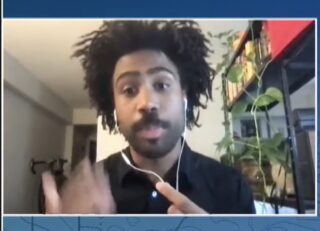

Task Force member Stephanie Frederick (spelling?) explained why she supported the policies even though she’s primarily a car user: “We car owners – I am one – don’t pay anywhere near the full cost of the driving we do,” she said. “We don’t pay for the asthma and other illnesses we inflict on exploited people trapped in housing along freeways on busy streets. We don’t pay for our role in the climate crisis that is most injurious to the most vulnerable amongst us. We don’t pay for noise, harm or economic losses due to congestion. It’s no wonder we’re out there in droves, doing damage.”
And The Street Trust Policy Manager André Lightsey-Walker gave testimony that was so convincing and inspiring several commissioners referred to it before voting “yes” a few minutes later. Here’s part of what he said:
“You will have the opportunity to set precedent, at a pivotal point in the region’s history, where conversations of pricing are coming up at local, regional, and state levels. Let’s work together to re-establish Portland as a global transportation leader and use our influence and successes as a model for how urban areas can do pricing right…
People will be angered by the prospect of paying for something they’ve cognitively established as free, whether it’s plastic bags, parking in their neighborhood, or crossing a bridge. And adverse response to this change is expected. However, as leaders in our community you have the unique responsibility of helping people understand that the things they perceived as free have actually been quite costly, causing generations of harm to our environment, health, and our most vulnerable communities, and that our current systems will continue to do so without urgent strategic and innovative intervention. I ask for your continued leadership as we move forward… designing streets for people is justice in action.”
Now that the POEM recommendations have been adopted, PBOT and BPS are bound by the resolution which calls on them to return to council within nine months, “with an update on all strategies and an implementation plan for the nearer-term equitable mobility fees and investments.”
Stay tuned.
— Jonathan Maus: (503) 706-8804, @jonathan_maus on Twitter and jonathan@bikeportland.org
— Get our headlines delivered to your inbox.
— Support this independent community media outlet with a one-time contribution or monthly subscription.

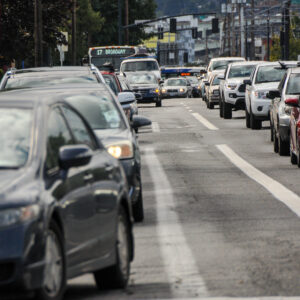
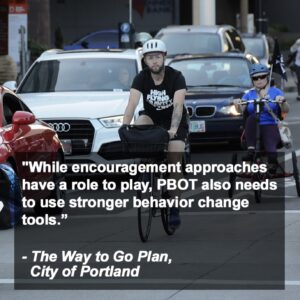

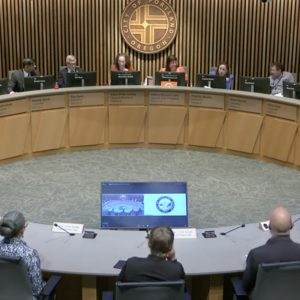
Thanks for reading.
BikePortland has served this community with independent community journalism since 2005. We rely on subscriptions from readers like you to survive. Your financial support is vital in keeping this valuable resource alive and well.
Please subscribe today to strengthen and expand our work.
I sure hope RVs are included in this proposal 🙂
Good idea…though hopefully not “truck campers” since they don’t have wheels or an engine…and thus their impact would be included in the truck carrying them.
Truck campers already pay a separate registration fee based on length as if they were trailers
With all of the language around means-based fees, I am surprised there is no proposal to charge high earning folks who work from home simply because they can avoid most of the fees.
Provide exemptions for households living on low-incomes.
• The City should develop one set of income-based policy standards that can be applied to
current and future pricing programs to limit administrative costs and complexity.
• Until a universal basic income can be guaranteed, exempting households living on low incomes should be the highest priority to avoid exacerbating current inequities.
• When exemptions are not possible, cash rebates or payments to households living
on low-incomes is preferred as it allows individuals to make the best transportation
decisions for their personal situation.
Reduce unequal burdens of technology and enforcement.
• Tickets and fines for non-compliance should be means-based (i.e. structured by income
level) to mitigate disproportionate impacts
“Provide exemptions for households living on low-incomes.
• The City should develop one set of income-based policy standards that can be applied to current and future pricing programs to limit administrative costs and complexity.”
How about basing it on food stamps (SNAP) and/or public housing? If you are already a recipient of either program, then you are automatically exempt, thus reducing the admin costs?
Because when these folks drive, their impact is less? Not only would exempting a segment of the population help defeat the purpose of the initiative, it would make others less likely to support it.
If you’re really concerned about financial impact, give folks a stipend that can be used to offset a reasonable amount of driving (however that is defined), but could be pocketed as an incentive if they cut back.
Do you expect that level of deep dive from a city that couldn’t figure out to exclude safe travel locals from a floodplain?
MOTRG,
I think you might meed to change your name to far left liberal guy.
I’ve been all over that, MOR.
Decades of research into the driving habits of “work form home” households shows that they drive almost as much as “commute to work” households. In essence, working from home is a form of “induced demand”.
Driving data from this “work from home” era has validated these studies in a massive natural experiment:
[Portland data from: https://covid19.apple.com/mobility%5D
Also see delayed data:
https://www.fhwa.dot.gov/policyinformation/travel_monitoring/21jultvt/21jultvt.pdf
PS: Another one of my fierce political disagreements with urbanists/shoupistas who seem to think that “work from home” is progress.
The charts in your second link all show a reduction in total miles from 2019 to 2021, except in rural areas.
A large swathe of people are still working from home so the return to 2019 levels of driving in June/July in urban areas is making my point. And those numbers are in uncanny agreement with Apple mobility numbers that show a return to 2019 levels in every major urban centers by June/July — with a continued rebound into Sept.
It’s also odd that you see any disagreement with my summary of the previous academic literature that “work from home” people tend drive almost as much as “commute to work” households (e.g. only slightly less).
Up-to-date Apple Mobility date for Portland:
The Census Pulse Survey suggests that ~60% of USAnians worked from home as of Sep 15-27:
https://www2.census.gov/programs-surveys/demo/tables/hhp/2021/wk38/employ4_week38.xlsx
(Portland’s percentage of “work from home” is almost certainly higher than the national percentage.)
You know what is exciting the city councilors about these new revenue sources? They can now figure out new ways to take away those revenues from PBOT and deliver them to the general fund to pay for police, fire, parks, etc, just like they did with previous special transportation revenue sources like the ULF (utility license fee – the fee collected from utilities for ripping up the street.)
The Task Force, don’t forget the Task Force on Finding and Spending New Revenues (TFFSNR).
Making it more expensive to drive and park without providing viable alternatives is a pretty awful thing to do imo.
My neighbors couldn’t realistically take public transit or bike if they wanted to. The bus system out here is basically useless for going anywhere in a reasonable amount of time and even if you were brave enough enough to bike from St. Johns to downtown, that’s quite a ride through unsafe streets.
It seems like the goal for reducing SOV trips should be by making transit and biking a nicer alternative over making driving more expensive. Hell, maybe in 15 years we could get to a place where its unreasonable to drive from outer Portland but today its not the case.
Maybe we should tax SOVs based on where they live? Target the folks driving from Buckman to the Pearl for work instead of working class folks in St. Johns or Lents.
It would make more sense for folks who make longer trips to pay more, as they externalize far more costs than those making shorter trips do.
In an inequitable system maybe. Folks who have to drive more usually have less means. Believe me, I didn’t pass on a house in the West Hills, I couldn’t afford it.
Taxing people who can’t afford to live close-in more is just a double ‘f u’ because they already have to waste more of their time commuting. You want to charge them extra because they can’t afford to live close to work?
So, maybe we should pay cash incentives for people who live further away? Maybe we should mandate that their employers pay them for their commute time, too. That would be a real Portland solution – another monetary mandate put on somebody else.
Paying cash incentives to low-income people who were pushed out of bougie inner Portland makes an awful lot of sense.
It’s nice to see you develop some empathy for the bottom 70%, J_R!
What about employers giving benefits or perks towards the cost of housing for living within a certain distance of where they work? I mean the west hills is a bit extreme of an example, if everyone who lived in the central city had as much space as people in the west hills do, then the central city wouldn’t be dense at all. Depending on someone’s family situation, there are a good amount of old small apartments in the central city, some for cheaper at least relative to everything around it just at the foot of the west hills too. I mean this would require much more construction in the medium-long term too I guess, but this would also promote infill and densification of close in areas
I’m opposed to anything to further chains a workers standard of living to their employer. Besides, we live in a metropolitan area, people shouldn’t have to move every time they get a job.
We just need a coherent transportation system that allows people to move about the metro in a reasonable amount of time outside of a car. Lots of other places have achieved that. There is no reason we need to set up so complicated tax/benefit situation. If you build good stuff, people use it.
Yeah that’s a good point about being tied to your employer. I think transportation costs are at least indirectly if not directly related to someone’s standard of living, would you be opposed to the commuter benefits for alternative transportation by employers discussed in the article? If a city/metro has an obligation to provide safe, efficient, accessible, affordable transit, I think the same could be said for housing that is accessible to a job. Not that there should only be one of those. (Sorry for the multiple posts, Jonathan it wasn’t loading for me from the mobile site?)
I’m not opposed to it but I don’t think it will move the needle in the slightest for modal share.
If driving your car takes 20 minutes each way and taking a bus takes 40 minutes, moving to transit would an additional 173 hours of commuting time for someone who works 260 days a year. Add on the flexibility of being able to leave whenever you want and I think most people are going to choose to drive.
Our transit system is so poor, it just isn’t an alternative at any cost for most people. I think the large majority of people would pay $200 -$300 a month to avoid taking TriMet so I don’t foresee a free bus pass getting them out of their car. It wont hurt I guess.
All cities have areas that are not well served by transit. You happen to live in one, which may color your opinion on the topic. I’m not a huge fan of post-pandemic TriMet, but, given our geography, it’s not a terrible system compared to other cities, especially American cities, of similar size.
@cmh89 I guess I am not clear what the purpose of imposing a cost on driving is if you exempt anyone who suffers the inconvenience of not living in the central city (including those in the West Hills or West Linn who have no access to transit). I also don’t know how you build the political will for such a system, nor, really, how you would implement it.
Depends. If I make multiple short trips for singular purposes as compared to a longer trip for multiple purposes (trip chaining), the longer trip is probably more efficient.
It’s only more efficient because your chained trip is shorter than the combined length of your multiple trips.
You need to consider cold starts versus warm starts.
https://www.caee.utexas.edu/prof/kockelman/public_html/TRB15coldstarts.pdf
Agreed, assuming your stops are short enough your engine doesn’t cool too much.
I was going for big picture: long trips have more impact than short ones.
To be fair, it means less and less with the more efficient engines and EVs. There are so many variable to consider – like what time those trips are made, age/efficiency of the vehicle, driving style, etc…
Yes, new pricing should be paired with investments in biking & public transit infrastructure so alternative means of transport are viable. That point was made explicitly & repeatedly throughout both the summary document & the presentation presentation to city council.
“Investments” are great. We’ve been “investing” for decades. Massively increasing the cost for working class paired with some limp new commuter choo choo isn’t going to solve anything.
Build infrastructure first, not pair if
Multnomah County says they don’t get a kick-back from the permit stuff when a new house is built in unincorporated Multnomah County unlike at least the suburban areas of unincorporated Washington County where new homes are being built. MultCo cites this as one reason why they don’t have as many stroad or street projects being built compared to Washington County. Also, there is no investment in allowing metal-studded car tires in Oregon, but there is clean-up, repairs, noise, increased stormwater pollution, and no fees.
Agreed. Not only is the public transit system useless for many folks, it’s also unsafe. And this city seems very uninterested in changing that. The east side of town is quite a terrible place to ride a bike as well for many of us.
I don’t think the typical progressive-urbanist gives a d*mn that transit and bike-ped infrastructure really s*cks on the periphery or that many live there because they can’t afford to live in bougie Boise or Buckman.
Sadly I think you right Soren. Lots of talk and nice PowerPoints regarding the future. But overall the east side of town is a pretty depressing place to live and raise a family.
Rather than penalize people based on where they live, this is where we need a “complementary strategy” such as the Task Force and PBOT staff recommend. TriMet’s Line 16 takes about 26 or 27 minutes to travel from Lombard & Burlington in St. Johns to SW 1st & Oak. Travel time isn’t the problem. It’s the fact that the frequency of the 16 is a bus every 40 minutes, that currently makes this a worthless option. Increasing the frequency of the 16 should help make transit a nicer alternative. I hope the City of Portland pushes TriMet in this direction, and offers financial support from any pricing options that it implements.
I agree with you and will point out that very few people live at the corner of Lombard & Burlington. Add 10+ minutes for getting to the bus stop and it’ll be even more useless.
St. Johns to downtown is around 45 – 50 minutes monday through friday if the times are actually convenient. Using tansit to go to my 8-5 job downtown would have taken around 2.5 hours round trip between waiting for the bus and riding. It’s an 1.5 hour trip by bike and 1 hour trip by car.
The current OR licensing fee methodology misses other points per environmental ‘impact”*)
*Interesting that a heavy truck (Heavy Vehicle Title up to 26,000 lbs GVWR) has a lower title fee ($90) that an ATV or moped etc. ($98) in Oregon., go figure. Not to say that a $98 fee for a 2 cycle moped absolves it from the air quality impacts…but $90 for heavy trucks seems to miss their impact on the road surface even if they tend to buy more fuel per mile travelled.
https://www.oregon.gov/ODOT/DMV/pages/fees/vehicle.aspx
You may have misread the fee schedule. Trucks below 26,000 lbs GVWR pay a $98 title fee, same as other light vehicles. It is trucks over 26,000 lbs GVWR that pay a $90 title fee, but they also pay a weight-mile tax. Heavy trucks also pay a lower diesel tax. ODOT conducts periodic “cost responsibility studies” to supposedly make sure that heavy vehicles pay their fair share via the weight-mile tax, per a constitutional requirement. I am skeptical that they do, but I will leave that fight up to others who have more data.
Let me guess. There will be zero enforcement on any rules and regulations. The city almost never enforces the current parking limits in my local business districts. Why not do that before adding more layers of laws that will be deemed unenforceable because they will disadvantage someone?
It sounded all good, until this last paragraph:
NINE MONTHS? For an *update* about *strategies* and implementation *plan*?!? This just sounds more like the same: big resolutions, bit plans, little urgency to actually do something.
Funny you say that. I agree with you in heart… but to bureaucrats this 9 months is seen as a very quick turnaround. Keep in mind, I think they expect more than a mere update in 9 months. My sense is they want to see actual policies/plans ready to put into motion. We’ll see
climate change requires more immediate action! If we had waited longer to respond to COVID, think about how much worse it could have been….We need to proceed with a sense of urgency, and not a sense of bureaucracy! Plus, anyone can see there will be pushback which will need to be dealt with, and I don’t think our current leaders or form of government are up to it.
I agree with you Jonathan — that’s what we have learned to expect.
But I am asking us to expect more. I have seen too many cycles of announcing well-meaning reforms — bikeplan 2030, VZ, etc. –, followed by a lot of planning, and then implementation of a few, small infrastructure changes that have failed to meaningful change our transportation infrastructure because they are too small in scale, take too long to implement, and require too many resources.
What I would like to see is a systemic response to these systemic issues.
To take a concrete example: cut-through traffic on bike routes is an ongoing and systemic issue. This affects about 100 miles of neighborhood greenways (https://www.portland.gov/transportation/walking-biking-transit-safety/biking-portland). With 30 blocks per mile (https://www.uponarriving.com/how-many-city-blocks-in-a-mile/), that makes about 3,000 blocks of greenway to protect from cut-through traffic. Assuming we want to install a barrier every 6 blocks or so (1/5 of a mile), then we would need 500 barriers. Some areas won’t need one (because of existing barriers, natural barriers, etc.), so let’s aim for 400 barriers.
So a systemic response to cut-through traffic would mean installing 400 barriers in a few years, say 4 years. The planning stage would involve designing 3-4 barrier models and identifying 400 spots. The latter needs to be routinized so that we can proceed at a good pace (say identify 10 spots per day, or all 400 in 40 business days, i.e., 8 weeks). Then the implementation stage would involve putting 2 barriers on streets every week, 50 weeks per year, for a total of 100 barriers per year. Do that and you will see real change in how people use our streets within a year or two.
I am laying this out to contrast it with the half-hearted, piece-meal, small-scale approach that PBOT and the city has followed for too long. Once you sit down and figure out the scale of the problem, it becomes obvious that our current policy planning and implementation approach is utterly flawed.
Stephan,
You’re telling me to expect more? Dude, seriously. I feel you and I get it. This is not my first rodeo.
It is very simple to share your big idea on how to fix everything. It is not as simple to actually make the sausage and get shit done. I sometimes come on here to back up PBOT because I want to encourage folks to come to grips with the reality that bureaucracy and politics exist and just hoping/praying/saying what you want isn’t enough. We need to move past proclaiming what we want and we need to get more involved with actually making it happen. PBOT operates under real constraints and I think some folks just think they can wave a magic wand and get shit done. They can’t! There’s internal egos, political realities, special interest pressures, and so on and so forth.
I’m tired of internet commentators who think all it takes is a good idea to fix everything. Ideas are the very easy part.
Obviously I agree with you that PBOT isn’t moving fast enough. I think everyone knows that. Even PBOT staff admits it after a few beers. We are all frustrated here. Please don’t assume that just because I present a different perspective that I don’t get it.
I love your idea! How can we implement it? Have you connected with Bike Loud or The Street Trust? Have you shopped it around your n’hood association? Have you shared the idea at a bike advisory committee meeting or open comment period at City Council?
Don’t just tell me about your idea, tell me what you’ve done to make your idea a reality.
Thanks Jonathan, for the suggestions and the candor! I am sorry that my comment was annoying, and I can see how these types of comments are tiring from your perspective. I will be more mindful about that in the future.
One of you is talking about policy and the other about implementation.
You need to form a Barrier Equity Systemic Stakeholder Advisory Committee (BESSAC) made up of BIPOC community members and paid nonprofit industrial complex staff, with a Barrier Technical Advisory Committee (BTAC) made up of engineers, fire officials, and Freight Committee stakeholders to veto any controversial proposals from the BESSAC. Maybe sometime soon, in 5-15 years, the project will get on the PBOT budget, then cut 10% 3 months later.
I’m laughing out loud and it’s before noon!
They make it easier to cash out and move. The equity portion should be enjoyable to hash out. Maybe less of a few for those of us who have weak alternatives to driving? .5 a mile to a bus, even further for a train, and a very shoddy greenway system.
There’s quite a lot the City can do with that money right now, even without a constitutional amendment. Currently, motor vehicle & gas tax revenue
(That’s Or. Const. Article IX Section 3a, for anyone who is curious.)
There’s a lot PBOT can do to reconstruct, improve, repair and maintain roads and streets that will support safer pedestrian and bicycle use, including road diets and traffic diversion.
A 1981 Attorney General Opinion (OAG 81-52) says that motor vehicle tax revenue can be used for facilities “solely for bicycle and pedestrian travel” as long as they are within the highway right of way, as they are “deemed to be a part of the highway itself” (just as “sidewalks for use by pedestrians is a proper use of highway fund money”). So a pedestrian/bike viaduct over a freeway like Ned Flanders Crossing would be eligible for gas tax funding as “within the highway right of way.” The same principle would apply to cycle tracks.
If they wanted to, PBOT could put all of its gas tax money into “in road” pedestrian and bike improvements, along with road diets, traffic calming, and safety improvements, even working within current constitutional constraints.
There is no legal reason that the $207,895,373 in ARPA covid-stimulus funding that Portland received couldn’t be spent entirely on bicycle and pedestrian-related infrastructure, nor even the local funding going to police and/or parks. But it will never happen. It goes against your local and statewide mindset – that transportation revenue MUST go only towards transportation infrastructure (by Oregon state law but pretty nearly no other state) – and therefor (illogically) no other non-transportation revenues may ever be used for transportation projects (even though they can be legally used as such.)
I know this is counter intuitive, particularly for Oregonians, but when any government requires any particular set of tax revenues be used in a certain way, such jurisdictions then get into a rut that any other revenues should never be used for that same purpose even when they legally can be. So in the case of gas taxes, parking revenue and vehicle registrations, the fact the Oregon only allows those revenues to be used for transportation infrastructure has usually meant in practice that any other local revenues generated such as income tax or property tax will almost never be used for transportation infrastructure even though they legally can be.
In many jurisdictions (usually outside of Oregon) that allow gas taxes and other transportation revenue to be lumped in with all other revenue sources and spent on practically anything (police, fire, schools, housing, prisons, etc) will often spend far more revenue (as a percentage of the total) on transportation projects precisely because there are no legal inhibitions to do so – if transportation infrastructure or operations is a local priority over all other priorities, then it will more likely be taken care of.
And so the law needs to be scrapped, so you all can get out of this mindset that seems to be limiting your collective ability to make any significant transportation improvements – you need $600 Million to implement just the BMP 2030 and you ain’t gonna do it by spending a few million every other year. By lumping all your funding together into a big pot, you can then have very serious conversations about transportation versus policing versus housing, and what really needs to be prioritized.
Generally true although 82nd Avenue is proving to be the exception. A large portion of the money is coming from the State’s ARPA pot.
Glad to hear that not all the ARPA funds are being pissed away piecemeal. And TriMet is largely supported with a payroll (income) tax. But we are talking about PBOT and the city here, not ODOT nor TriMet.
We have to face facts like it or not. At the current rate of change of the cost of fuel, and the cost to operate and own a motor vehicle ( of any kind) half the population will not be able to afford it in 5 years, even if no additional costs are involved. So analyzing the effect of these added fees on various groups is like treating the acne on a gunshot victim.
You are mixing up market price volatility with lang-term trends. Remember April 2020 when crude oil briefly fell below $0 per barrel and producers were paying storage fees for the excess oil supplies? The rise since then has been neither steady nor record-setting (it was over $120/barrel briefly in 2014). Yeah, there’s a current energy crises, but like the chip and derailleur shortage, it’s not being caused by a lack of production nor a high demand, but rather by a severe distribution disruption – a nasty combination of local covid lockdowns overseas, local worker shortages, disrupted loading and unloading of ships, and a booming economy. Everything should be back to “normal” within 2 years, including cheap gas, alas. I expect to see a period of rapid price deflation within the year for certain commodities such as microchips, 9-speed cassettes, and beef.
exactly how is punishing motorists of benefit to cyclists when using a fisheye lens ?
like sheesh. . . its great to piss off people driving multi ton vehicles where i want to pedal a 14 lb bike
DUH !
Did you link the right article? It is taking me to “Eliminate Cars and Traffic Cops or Keep Cars and Traffic Cops”
Yes it’s the right link.
Is this the tie in that you are referencing? There won’t be a worry about traffic tickets and suspended licenses if you can’t afford to drive?
If people didn’t have to drive then expensive traffic tickets and license suspensions hurting low income people wouldn’t be a problem.
An obscenely expensive plan with virtually no public buy in (including among the supposed beneficiaries) to be funded by massive fees on everyone except a tiny group that thinks this is a great idea– how could this not succeed?
Imagining a new future is easy. Figuring out how to get there from what we have with the actual people and resources we’d be working with is another matter.
There are a few ideas in there that probably can and should happen. But sticking them in a plan with only the most tenuoys connection to reality minimizes their chances.
Also, how do the victims of the externalities actually benefit from this? It’s one thing to reduce externalities – it’s another think to make those people whole again in the economic sense.
It’s illustrative that “portland leaders” punted on the things that might significantly reduce toxic and ecocidal cage use: congestion pricing [a central city cordon (toll) zone] and local road-use fees.
I will make a prediction:
5 years from now Portland’s consumption CO2e emissions will be far higher than they are today and commenters will still be debating inadequate unfunded plans.
I used to be excited about a cordon pricing system until the Covid-19 pandemic destroyed the peak-hour demand for driving downtown that would have been the entire justification for a cordon pricing system. The only way a geographical cordon price makes sense, as opposed to pricing driving more generally throughout the city, is if you have very high demand for people trying to go to one small area. A cordon price won’t make sense for a long time, if ever, given the rapid shift to more working from home and less 9-5 office demand.
As for local road-use fees, the technological start-up costs are massive and completely unnecessary. How would you actually price VMT on the entire roadway system? You can do it for fleets, maybe, where you have ways to track them, but not private cars. But the thing about cars is they always have to be parked somewhere. So you can accomplish road-use fees much more efficiently through fees on parking in both on-street and off-street parking spots. What if you had to pay a base fee to park anywhere in the city, and then high-demand areas had an even higher surcharge? That’s what we ultimately need. And we know that the cost (and hassle) of parking is the biggest determinant of whether people will switch to other modes. That’s always been true, which is why it’s exciting to see a lot of parking-related proposals here.
Despite the criticisms raised in BP’s comment section, this is a huge step in the right direction to price driving in a way that more accurately accounts for all of its negative externalities. The project is acknowledging that offering up transportation “options” or “alternatives” has failed to curb ever increasing rates of driving – people need a signal in the form of higher costs. That said, yes, we need better transit options. Heck, if driving becomes a lot more expensive whether through market realities or through pricing policies, perhaps we’ll have a bunch of new transit advocates coming out of the woodwork. And finally, while I’m thinking about transit – where the h*** is TriMet in all of these discussions?! Where is our regional transit leadership and why are they not taking advantage of the city, regional, and state discussions on road/congestion pricing? The silence is deafening.
Improving options is the carrot and really has to happen – Riding TriMet regularly (I’ve been car-free since .. Dec. 1987 IIRC) is an exercise in patience and managing expectations.
At the very least we need expanded service (both in areas covered and frequency) and bus only lanes.
The ability of transit to bypass congestion is one of the features that can really appeal to people. I’ve been on the MAX going by stopped traffic on the neighboring highway. That sort of (slightly smug) feeling goes a long way to validating someone’s choice to ride transit – even when it’s pretty crowded.
Being on a crowded bus stuck *in* the traffic does quite the opposite.
That said, we need the stick. The best way to reduce the use of something is to increase the cost. As a for instance – nicotine is one of the most addictive drugs known, but a $20 increase in the cigarette tax (ranging from 33% to 66% increase in the purchase price) resulted in carton sales in the state of Oregon falling by 25%.
Yes, that’s going to hurt lower income folks who can’t figure out how to get away from car dependence – but a cheap car driven by a minimum wage worker dumps just as much (if not more) carbon into the air, puts just as much micro particle pollution into the air, damages streets just as much and kills pedestrians/cyclists just as easily as a BMW driven by some well off white guy.
Also, if we provide usable alternatives, in the long run the lower income people benefit the most from being able to lose the car. I’ve been one of those people – I was out of work for 18months while going back to school in 2002/2003 then laid off in 2007 and we lived on a single (above median, but not dramatically so) income.
In the end, my GF and I are living proof that you can live without a personal vehicle. We didn’t just survive periods of lower income, we thrived – and not having to pay for a car (or worse, 2) is a big part of the reason.
Many of the poorest parts of town lack any sort of nearby bus service, nor any safe ways of getting to the nearest bus stops. The lack of bus service and poor connectivity partly defines what is affordable – well-connected parts of town generally charge higher rents and have higher land values, often with more amenities. The best way to reduce the use of something is not to increase the cost, but to make it useless and non-connecting so that no one is willing or able to use it, and public transit, walking, and bicycling infrastructure in East and SW Portland is utterly useless.
Thanks for saying this, David. I’ve got a pair of articles in my head (and I already have the photos) that I need to write. One is a street in SW, one in EP. Neither have sidewalks, but the way to improve safety on each of them is very different. EP has very acute needs, as you know. So does SW in places, but for me the bigger SW concern is long-term, Portland has got to get SW out of cars, but yeah, that requires a place to walk, a bus line to walk to, and/or a protected bike lane. The city should be providing an alternative to driving.
And it is starting to, the Capitol Highway project is a big game-changer for the area between BHH and Barbur.
What is your EP example?
The rest of the state might agree to it if it provided funds for enforcement.
Cost me over $200 for new tabs, registration, smog test every 2 years on a mid-90s HONDA CIVIC! That’s way too much.
I could not find good data on the average amount of taxes paid by commercial trucks, but it is high. Not only do they have to pay high taxes, but the regulations the drivers must comply with are onerous. To top it off, many companies treat their employees like ship, and they rarely get to see their families. They deliver all the crap we buy and are working for peanuts in a crappy, stressful job. Got to give the poor farkin bastiges some respect.
Why don’t all the greenie car haters move some place where there aren’t many cars? It’s a big old world – there must be some place that would have few cars, no? Even here in Oregon if you lived in say, Ukiah or Meacham, you could no doubt find lots of places to ride with few cars.
Lots of you could no doubt move there and work from home via the internet/phone/etc.
Don’t bring your leftist ideas with you to those places though – they aren’t interested and you have no right to ruin their lives with your false beliefs.
You’re funny Bronc Rider. You think fighting cars is leftist. Ha! Glad to have you here. You’ll notice I deleted several of your comments. I welcome your perspective, but I’ll delete everything that’s not constructive or respectful of others. Happy commenting!